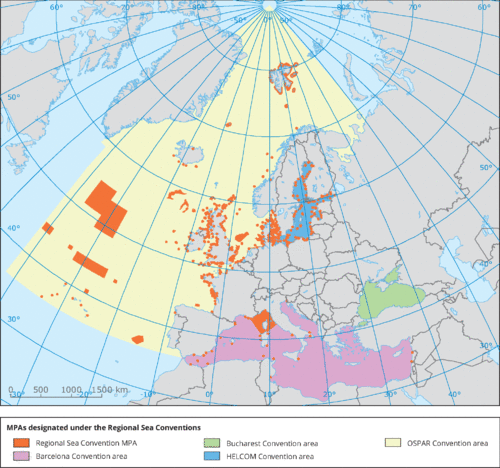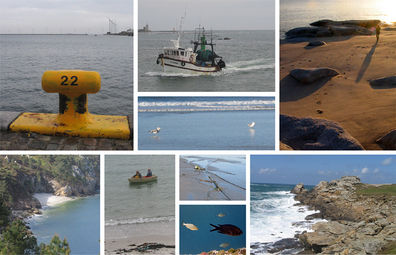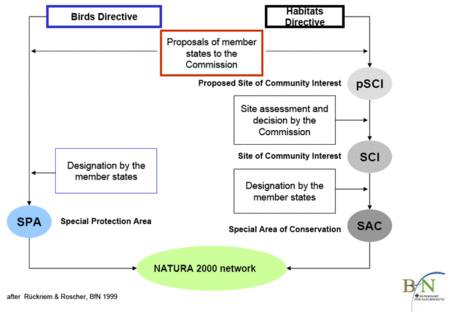Marine Protected Areas in Europe
This article deals with Marine Protected Areas (MPAs) in Europe. It is structured in two main parts. In the first section, the reader obtains background information about Marine Protected Areas in general which includes relevant definitions and introduces the different types of MPAs. Furthermore, the main ecological as well as socio-economic benefits of MPAs are summarized. The second part of the article focuses on the implementation of Marine Protected Areas in Europe. An overview of the most important international/regional as well as European legislation relating to MPAs is given. In addition, the designation process of MPAs under the Birds and Habitats Directive is briefly described and the current status of marine Natura 2000 sites is outlined.
Contents
Introduction
In Europe as well as in other parts of the world, concerns about the continuing decline of marine biodiversity have risen. Independent reports about losses in marine species, depleted populations of commercial fish stocks and increasing human pressures on marine ecosystems demand an immediate management response.[1] . Nevertheless, at present the world oceans are still seriously underprotected. According to a 2017 inventory, an estimated 6.35% of the ocean was protected. However, only just over 1.89% was covered by exclusively no-take MPAs that do not allow any fishing, mining, drilling, or other extractive activities[2]. According to the Marine Protection Atlas about 2.7% of the world oceans was fully protected in 2020. This is far from the commitments of States made in relation to the Convention on Biological Diversity’s (CBD) Aichi Target 11 of 10% MPA coverage by 2020[3], and even further from the recommendations made at the IUCN World Parks Congress 2014 that at least 30% no-take MPA coverage worldwide is needed[2]. Since it is commonly acknowledged that marine biodiversity plays a fundamental role in supporting a wide range of ecosystem goods and services, efforts have been made to conserve ecologically valuable marine samples. Today Marine Protected Areas (MPAs) are recognized by most countries and regions in the world as an important instrument to conserve marine ecosystems. In Europe the implementation of MPAs is driven by several international, EU and regional obligations and initiatives.
Definition
A Marine Protected Area (MPA) is a clearly defined zone in the sea which by some level of restriction protects living, non-living, cultural, and/or historic resources from harmful human impacts and environmental pollution. MPAs often encompass areas of high ecological value whose marine biodiversity is protected and preserved for the benefits of present and future generations. Marine Protected Areas are perceived as instruments for improving both fishery management and marine environmental protection. Besides protecting the respective marine ecosystem’s structure, function and integrity, MPAs also can support more sustainable fishery management.[4]
Several definitions of Marine Protected Areas have been formulated and applied in different conservation and management contexts. The internationally most commonly cited definition is the following:
“Any area of the intertidal or subtidal terrain, together with its overlying water and associated flora, fauna, historical and cultural features, which has been reserved by law or other effective means to protect part or all of the enclosed environment”[5]
Types of MPAs
Beyond the above mentioned general definition, IUCN classifies six types of marine protected areas, depending on their targets:
Category I - Protected area managed mainly for science or wilderness protection (Strict Nature Reserve/Wilderness Area);
Category II - Protected area managed mainly for ecosystem protection and recreation (National Park);
Category III - Protected area managed mainly for conservation of specific natural features (Natural Monument);
Category IV - Protected area managed mainly for conservation through management intervention (Habitat/Species Management Area);
Category V - Protected area managed mainly for landscape/seascape conservation and recreation (Protected Landscape/Seascape);
Category VI - Protected area managed mainly for the sustainable use of natural ecosystems (Managed Resource Protected Area)[5]
Benefits of MPAs
Studies show that Marine Protected Areas entail several benefits to humans as well as to nature. The main advantages can be very roughly summarized under the subsequent four categories:
- Protection of marine ecosystem structure, function and integrity
- Fishery management / sustainable natural resource management
- Education and research
- Recreation / tourism
Marine Protected Areas protect marine ecosystem structure, function and integrity. Critical marine habitats and their natural communities, composition and functioning can be preserved. In addition, MPAs allow for the recovery of depleted populations, protect spawning populations and safeguard genetic resources and biodiversity. Besides having various positive effects on nature, MPAs also can directly be profitable for human beings. Marine Protected Areas foster sustainable fishery management and reduce overfishing. MPAs offer undisturbed spawning sites and enhance eggs and larvae production. The abundance of overfished stocks inside as well as outside of the protected area increases. Consequently in the long run local fishery yields can increase leading to higher incomes of local fishermen. Furthermore, MPAs can constitute ideal research grounds for science enabling an improvement in the understanding of marine ecosystems. MPAs can provide possible long-term monitoring sites for data collection. Also marine ecotourism that is compatible with zoned MPAs can be a very profitable leading to additional income for local inhabitants[6].
Legislation relating to MPAs in Europe
In Europe several legal arrangements are relevant to the establishment of MPAs. In the subsequent section a brief overview of the most important international/regional as well as EU legislation and strategies is given.
International/Regional Legislation relating to MPAs in Europe
The following international or regional agreements, conventions and treaties deal with marine nature conservation and apply to some or all Member States of the EU. In theory these international/regional instruments are legally binding for contracting parties, however in practice, their effectiveness is extremely dependent on the political commitment for national implementation[7]
Convention on Biological Diversity (CBD)
The Convention on Biological Diversity aims to build up a global network of comprehensive, effectively managed and ecologically representative national and regional systems of marine protected areas. The strategic plan 2011-2020 formulated the following target: by 2020, at least 17 per cent of terrestrial and inland water areas and 10 per cent of coastal and marine areas, especially areas of particular importance for biodiversity and ecosystem services, are conserved through effectively and equitably managed, ecologically representative and well-connected systems of protected areas and other effective area-based conservation measures, and integrated into the wider landscape and seascape [3].
Ramsar Convention
The Ramsar Convention obliges contracting parties to carry out measures for the conservation of wetlands. According to the Ramsar definition, wetlands can encompass near-shore marine areas[8].
Bern Convention
The Bern Convention aims to conserve wild flora and fauna and their natural habitats. Parties to the Bern Convention are required to nominate protected sites, which make up the ‘Emerald Network’.[9]
OSPAR and HELCOM
The Convention for the Protection of the Marine Environment in the Northeast Atlantic (OSPAR) includes a Strategy to protect and conserve marine biological diversity which aims to restore damaged marine areas. The Helsinki Convention (Helcom) contains provisions for the establishment of Baltic Sea Protected Areas (BSPAs) for the protection of species and natural habitats of the marine and coastal ecosystems of the Baltic Sea.
EU Legislation and Strategies relating to MPAs
In the following the most important EU legislation and strategies relating to MPAs are listed of which the first three are legally binding to all Member States.
Habitats and Birds Directives
The EU Habitat Directive (92/43/EEC) requires Member States to designate Special Areas of Conservation (SACs) to protect some of the most threatened habitats and species across Europe. Under the EU Birds Directive (79/409/EEC) Member States are obliged to classify Special Protection Areas (SPAs) for the conservation of specifically listed bird species. The sites designated under both Directives contribute to a Europe-wide network of nature conservation protected areas known as Natura 2000.
Common Fisheries Policy (CFP)
The CFP Regulation provides for the establishment of zones and/or periods in which fishing activities are prohibited or restricted as well as specific measures to reduce environmental impacts of fishing[10]: "The Union shall, while taking due account of existing conservation areas, endeavour to establish protected areas due to their biological sensitivity, including areas where there is clear evidence of heavy concentrations of fish below minimum conservation reference size and of spawning grounds. In such areas fishing activities may be restricted or prohibited in order to contribute to the conservation of living aquatic resources and marine ecosystems. The Union shall continue to give additional protection to existing biologically sensitive areas." The basic regulation does not require Member States to develop MPAs, but rather puts in place a legal framework through which they could be established.
Marine Strategy Framework Directive (MSFD)
The Marine Strategy Framework Directive (2008/56/EC) requires Member States to put measures in place to achieve or maintain good environmental status in their waters by 2020. Under the Directive a coherent and representative network of MPAs have to be created by 2016.
Integrated Coastal Zone Management (ICZM)
The Recommendation (2002/413) prescribes a holistic and long term perspective to managing the marine coastal environment. According to the recommendation MPAs in the coastal region are to be implemented within the context of integrated coastal zone management.
Implementation of MPAs in Europe
Designation of MPAs under the Birds and Habitats Directive
In Europe the Member States of the EU which border the sea are under the Birds and Habitats Directive obliged to designate marine protected sites which will ultimately contribute to a coherent European ecological network of protected areas known as Natura 2000. The EU Guidelines Report for the “establishment of the Natura 2000 network in the marine environment” gives Member States detailed instructions on how to apply both Directives properly. Member States under the Birds Directive are required to identify and select on a scientific basis (e.g. ornithological criteria) Special Protection Areas (SPAs) which represent the most suitable national territories for protection. Under the Habitats Directive Member States have to elaborate (according to specific scientific criteria) on a list of proposed Sites of Community Importance (pSCI) which is to be transmitted to the European Commission. After the adoption of the list by the European Commission, Member States can then designate Special Areas of Conservation (SAC) [11].
Progress on Natura 2000 MPAs
By the end of 2009, EU Member States had designated 619 marine SPAs under the Birds Directive, covering 97,507 km². In addition, a total of 1,391 marine proposed Sites of Community Importance (pSCIs), covering 131,459 km², were identified under the Habitats Directive. Most of these areas are very small (average size from Table 1, is 157 km² for SPA and 94 km² for pSCIs) and are in coastal and inshore waters, often as an extension of a terrestrial site.
In 2018, the number of MPAs of EU Member States under the Birds and Habitats Directives (SPAs and pSCIs) has increased to 3150 covering a surface of over 550,000 km², which is about 10 % of the total marine area of the Member States. Some regions exceed the 10 % target (Greater North Sea, Baltic Sea), but other regions still stay behind[12]. A map is shown in Figure 3.
| Country | No. SPAs | Marine area km² | No. pSCIs | Marine area km² |
|---|---|---|---|---|
| Belgium | 4 | 315 | 2 | 198 |
| Bulgaria | 14 | 539 | 14 | 592 |
| Cyprus | 1 | 21 | 5 | 50 |
| Denmark | 59 | 12180 | 125 | 16145 |
| Estonia | 27 | 6502 | 46 | 3752 |
| Finland | 66 | 5567 | 98 | 5460 |
| France | 73 | 33041 | 132 | 25709 |
| Germany | 15 | 16055 | 53 | 19768 |
| Greece | 77 | 1099 | 114 | 6344 |
| Ireland | 66 | 810 | 97 | 6014 |
| Italy | 45 | 2724 | 162 | 2254 |
| Latvia | 4 | 520 | 6 | 562 |
| Lithuania | 1 | 171 | 2 | 171 |
| Malta | 0 | 0 | 1 | 8 |
| Netherlands | 6 | 4895 | 14 | 10857 |
| Poland | 4 | 6490 | 6 | 3600 |
| Portugal | 10 | 622 | 25 | 775 |
| Romania | 1 | - | 6 | 1353 |
| Slovenia | 1 | 3 | 3 | - |
| Spain | 33 | 1034 | 97 | 7926 |
| Sweden | 108 | 4018 | 334 | 7512 |
| United Kingdom | 4 | 901 | 49 | 12409 |
| Total | 619 | 97507 | 1391 | 131459 |

In Europe the vast majority of MPAs are located in the territorial waters of the Member States. However, the European Commission demands an extension of the application of the Natura 2000 network to the Exclusive Economic Zone (EEZ). There are already some offshore sites, most notably in Germany which committed in March 2005 to protect 38% of its marine waters as MPAs, and nominated ten Environmentally Sound Fishery Management Areas within its EEZ.[4]
Discussion
It becomes evident that a well-managed European MPA network can play a crucial role in the conservation of both marine biodiversity and ecological processes and can make a contribution to sustainable development of the coastal zone. In order to arrive at a holistic and integrative MPA management approach it is important that all relevant ecological, social and economic factors are taken into account and that stakeholders become involved in the decision-making process. As far as the implementation record of MPAs is concerned in Europe progress has been made and the number of designated Natura 2000 marine sites has increased steadily.
See Also
Internal Links
Marine Protected Areas (MPAs)
Biodiversity in the European Seas
Effects of fisheries on marine biodiversity
External Links
- Natura 2000 in the Marine Environment
- German marine protected areas
- OSPAR Marine protected areas
- Council Directive 92/43/EEC of 21 May 1992 on the conservation of natural habitats and of wild fauna and flora
- Council Directive 79/409/EEC of 2 April 1979 on the conservation of wild birds
References
- ↑ Millennium Ecosystem Assessment (2005). Ecosystems and Human Well-Being: Current State and Trends. Chapter 18: Marine Fisheries Systems. Retrieved February, 2010 from: http://www.millenniumassessment.org/documents/document.287.aspx.pdf
- ↑ 2.0 2.1 IUCN (2017). Marine protected areas and climate change. https://www.iucn.org/resources/issues-briefs/marine-protected-areas-and-climate-change
- ↑ 3.0 3.1 CBD Aichi Targets https://www.cbd.int/aichi-targets/target/11
- ↑ 4.0 4.1 UNEP – WCMC (2008). National and Regional Networks of Marine Protected Areas: A Review of Progress. Cambridge: UNEP – WCMC. https://www.unep-wcmc.org/resources-and-data/national-and-regional-networks-of-marine-protected-areas-a-review-of-progress
- ↑ 5.0 5.1 IUCN (1994). Guidelines for Protected Area Management Categories. IUCN, Cambridge, UK and Gland, Switzerland
- ↑ Angula-Valdés, J., Hatcher, B. (2010). A new typology of benefits derived from marine protected areas. Marine Policy 34: 635-644
- ↑ IEEP (2008). Marine Protected Areas in Europe and the United States. A report from the transatlantic platform for action on the global environment. Brussels: Institute for European Environmental Policy.
- ↑ Ramsar Convention (1987). Convention on Wetlands of International Importance. https://www.ramsar.org/about-the-convention-on-wetlands-0
- ↑ Council of Europe (n.d.). Bern Convention on the Conservation of European Wildlife and Natural Habitats. https://rm.coe.int/1680078aff
- ↑ CFP Regulation (EU) No 1380/2013 https://eur-lex.europa.eu/legal-content/EN/TXT/?uri=celex:32013R1380
- ↑ European Commission (2007). Guidelines for the establishment of the Natura 2000 network in the marine environment. Application of the Habitats and Birds Directives. http://ec.europa.eu/environment/nature/natura2000/marine/docs/marine_guidelines.pdf
- ↑ 12.0 12.1 European Commission (2009). Natura 2000 Barometer. European Commission Nature and Biodiversity Newsletter. Number 27 December 2009. Retrieved February 2nd, 2010, from: http://ec.europa.eu/environment/nature/info/pubs/docs/nat2000newsl/nat27_en.pdf
- ↑ Marine protected areas in Europe's seas. An overview and perspectives for the future. EEA report 3/2015
Please note that others may also have edited the contents of this article.
|

